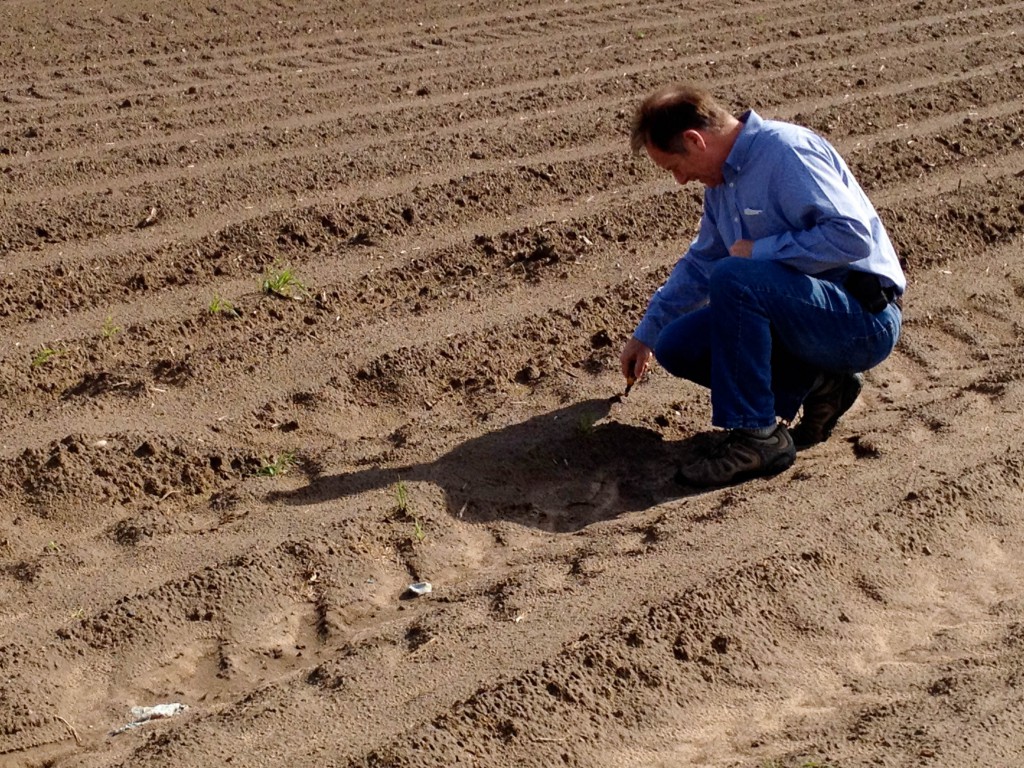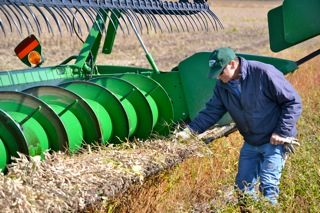Due to Congressional inaction, the 2008 Farm Bill has expired without a new bill or extension to take its place. In the absence of a farm bill, numerous innovative programs that invest in sustainable agriculture systems are shut down and left without mandatory funding. This is the second post in our 10-week “What’s at Stake?” series that highlights expired farm bill programs and what that means for farmers and communities throughout the country.
Steve McKaskle stands in his organic grain fields on McKaskle Family Farms in Missouri.
Photo credit: Anne Marie Goad
Demand for high quality, farm-based value-added food products – such as farmstead cheese, salsa, and grass-fed beef – is growing, and farmers are trying to scale-up their businesses and production to meet that growing demand. As farmers and farm coops consider growing their operations and adding value to their products, they can apply to the Value-Added Producer Grants program to help them plan and start-up new or expand existing businesses and local and regional supply chains. These value-added strategies help farmers and their local communities capture and retain a greater share of the total consumer food dollar, improving economic opportunity and growth in rural America.
Steve McKaskle of McKaskle Farms exemplifies the economic utility of Value-Added Producer Grants. McKaskle Farms grows a variety of organic grains in Pemiscot County, Missouri. McKaskle has already captured a relatively significant market: he sells in seven Whole Foods stores, two Fresh Markets, and several other health food and natural food stores. His lack of processing equipment, however, means missed financial opportunities.
“We are growing popcorn and rice and we are selling it to a buyer who is cleaning, milling, and packaging it and then selling it back to us at three times the amount they are buying the original products from us,” says McKaskle. “We are taking a strong look at doing these things ourselves.”
In early 2012, McKaskle’s farm received a grant for $40,000 to evaluate the financial feasibility of purchasing milling equipment for rice, bread flour, and cornmeal; cleaning equipment for popcorn; and packaging equipment for all of their organic products. The VAPG grant has allowed McKaskle to examine and evaluate options for scaling up his business. In fact, since receiving the planning grant in February, the restaurant chain Chipotle has already expressed interest in purchasing rice from McKaskle.
Through the planning grant, McKaskle knows he has overwhelming consumer demand for his products and in fact has additional buyers lined up. The next step will be to apply for a working capital grant through the VAPG program to purchase the milling equipment.
Purchasing the equipment and doing the processing on his farm will allow McKaskle to retain more of the value from his product. And what will McKaskle do with his savings? “Create more jobs,” says McKaskle. “We live in a poor county and want to help people on government assistance to break free from that.”
How Value-Added Producer Grants Seize Market Opportunities
The Value-Added Producer Grants (VAPG) program helps farmers and ranchers increase their farm income, create jobs, boost the economy, and increase consumer food choices. Through a competitive process, the program awards grants to agricultural producers and producer-owned businesses and cooperatives to develop new value-added businesses.
Value-added agriculture literally adds value to farm products and thus money to farmers’ pockets. A farmer will get more money per pound for selling salsa than tomatoes. When a dairy producer takes milk and turns it into cheese or ice cream, customers will pay more directly to the farmer. A farmer that produces and markets pasture-raised hogs instead of selling the meat wholesale makes a higher profit.
The economic recession has exacerbated depopulation and declining family income trends in rural America. Small-scale entrepreneurship is the one development strategy that consistently works in rural communities. Over half of all new jobs created in most rural areas come from small business ventures. The VAPG program is targeted at small business development and consistently contributes to farmer-led job creation in rural areas.
Since the program was first created in 2000, VAPG has funded over 1,500 projects throughout the country that have allowed our nation’s farmers and ranchers to realize successful value-added businesses. The grants support diversity and innovation, bringing local and regional products to market as well as strengthening the profitability and competitiveness of small and medium-sized farms and beginning and socially disadvantaged farmers and ranchers.
How is success ensured? The program funds business planning and feasibility studies to ensure the viability and long-term sustainability of the proposed project. VAPG awards are also made for implementing these businesses, and in these cases, applicants must show that they have done their homework first, to ensure the market demand exists for the value-added product.
The program also requires applicants to match their requested grant amount with their own funds and sweat equity, thus ensuring a high level of responsibility and dedication to any funded business enterprise.
More details about applying for VAPG grants can be found in NSAC’s Farmers Guide to Value-Added Producer Grant Funding.
Examples of Successful Value-Added Producer Grants
Through its smart design, VAPG helped expand market opportunities all across the country. Since 2000, VAPG has funded 1,540 projects in all 50 states and Puerto Rico.
A few program highlights include:
- In Nebraska, VAPG helped the Nebraska Small Farms Cooperative, which markets pre-cooked, USDA verified, non-hormone treated meat, expand from 29 farmers/members in 2004 to over 90 today.
- In New York, the Ives family used VAPG to plan and execute a successful marketing campaign for their premium ice cream.
- In Arkansas, Alter Farm received VAPG funds to study the viability of rice milling.
- In Washington and Oregon, 21 wheat growers used VAPG to expand the marketing of their “Shepherd’s Grain” brand.
- In North Dakota, VAPG allowed North American Bison Cooperative to conduct research around new and existing markets for bison products.
- In Georgia, VAPG helped Will Harris of White Oak Pastures get one of the only pastured poultry slaughterhouses in the South up and running.
- In Missouri, Prairie Pride, Inc. was able to build a new facility that converts soybean oil into bio-diesel fuel with its VAPG funds.
Status of Funding for Value-Added Producer Grants
VAPG was enacted as part of the 2000 crop insurance bill and at the time received $20 million a year in mandatory funding. That was increased in the 2002 Farm Bill to $40 million a year. In the 2008 Farm Bill, VAPG was one of just three programs in the Rural Development Title to receive mandatory funding, but its funding dropped dramatically to $15 million total for all five years of the bill, along with an authorization for additional discretionary funding.
The good news is that up to this point during the 2012 Farm Bill authorization, Congress has recognized the importance of value-added agriculture as an economic driver by increasing funding for the program over 2008 levels – though not back to its earlier funding level. Both the Senate-passed and House Agriculture Committee-passed bills include a total of $50 million in mandatory funding, or just $10 million per year. We hope that the final farm bill to emerge from Congress will at least get the program up to the $20 million per year average it has had since its inception.
What’s Next for Value-Added Producer Grants?
While Congress debates the new farm bill, like the other programs in our 10-week blog series, VAPG has at least temporarily lost its mandatory funding.
Unlike most of the other programs in this series, VAPG still has some funding, and USDA can proceed with a 2013 grant cycle. Why? VAPG has had, especially in recent years, both mandatory and discretionary funding. The Fiscal Year (FY) 2012 appropriations bill funded the program at $14 million, and the just-passed six-month Continuing Resolution for FY 2013, which continues to fund the federal government through March 2013, therefore contains the same $14 million for VAPG.
While some might consider VAPG comparably lucky, the truth is that until Congress completes the farm bill reauthorization, the program is far from where it should be. While the $14 million in discretionary funds is certainly better than nothing, it is not good enough. VAPG has more than a decade-long track record of successful rural job creation and sustainable farm income growth, which is exactly what this country needs. Congress should adopt a new farm bill this year and include at least $20 million a year in mandatory funding for VAPG.




Excellent summary of a relatively complex program. Your definitions was substantially more clear than the USDA version. Thanks